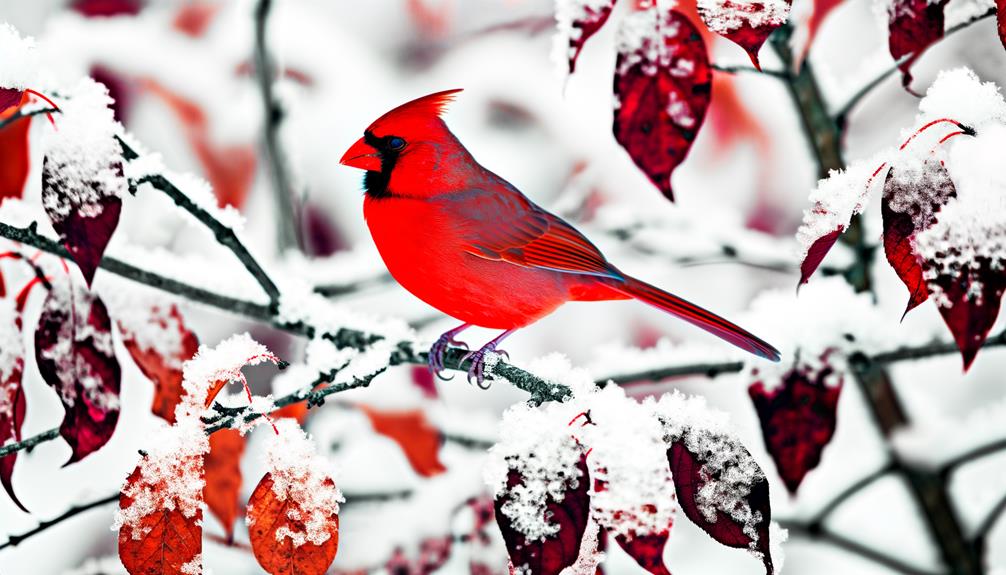Do Cardinals Turn Brown in Winter?
Northern Cardinals do not turn brown in the winter. Males maintain their vibrant red plumage year-round, a trait driven by stable carotenoid pigmentation from their diet.
This coloration is essential for attracting mates and deterring rivals. Females, however, retain their brownish-red feathers consistently, which aids in camouflage.
The hue and intensity of a cardinal's feathers can undergo subtle changes due to molting cycles, typically occurring in late summer, and environmental factors like diet and sunlight. These dynamics are well-documented through ornithological studies, providing a deeper understanding of this species' fascinating behaviors and adaptations.

Key Takeaways
- Male cardinals maintain vibrant red plumage year-round and do not turn brown in winter.
- Female cardinals consistently retain their brownish-red plumage throughout the year.
- Seasonal plumage changes are subtle and primarily due to molting cycles and environmental factors.
- Misconceptions about cardinals turning brown in winter are debunked by ornithological studies.
- Carotenoid pigments from diet are essential for sustaining the coloration of both male and female cardinals.
Cardinal Coloration Basics
Cardinal coloration is primarily determined by the presence of carotenoid pigments in their feathers, which are obtained through their diet. These pigments are responsible for the vibrant red hues observed in Northern Cardinals (Cardinalis cardinalis), with the intensity of the coloration directly linked to the quantity and quality of carotenoids ingested.
Carotenoids are derived from various plant materials and insects that the birds consume. Scientific studies indicate a strong correlation between diet and feather coloration, underscoring the role of nutritional intake in avian pigmentation. Additionally, genetic factors influence the absorption and deposition of these pigments, ensuring individual variance.
Understanding these mechanisms illuminates how cardinals maintain their striking appearance, a symbol of natural freedom and essentiality.
Seasonal Plumage Changes
Throughout the year, Northern Cardinals exhibit only subtle changes in plumage coloration, primarily due to molting cycles and environmental factors rather than a complete seasonal transformation. Molting occurs once annually, typically in late summer, allowing for the replacement of worn feathers. This process can lead to temporary variations in feather brightness and texture.
Environmental factors, such as diet and exposure to sunlight, also play a role in maintaining the vibrant red hue of their feathers. While some fading may occur in winter due to reduced sunlight, cardinals do not turn brown. Studies indicate that carotenoid pigments in their diet are essential for sustaining their coloration, highlighting the importance of environmental influences on their plumage.
Male Vs. Female Cardinals
Sexual dimorphism in Northern Cardinals is prominently displayed through the stark contrast in plumage coloration between males and females. Male cardinals exhibit vibrant red feathers, which serve various purposes including attracting mates and deterring rivals. Conversely, female cardinals possess more subdued, brownish-red plumage, providing effective camouflage while nesting.
This dimorphism is essential for understanding the species' ecological and behavioral adaptations.
Key differences between male and female cardinals include:
- Coloration: Males are bright red, while females are brownish-red.
- Role in reproduction: Males primarily attract mates; females focus on nesting and caring for offspring.
- Behavioral patterns: Males are more territorial and aggressive, whereas females are more discreet and nurturing.
This differentiation underscores the intricate balance of their natural roles.
Myth Vs. Reality
While the distinct coloration between male and female Northern Cardinals is well-documented, misconceptions about seasonal plumage changes persist. Contrary to popular belief, Northern Cardinals do not undergo a significant color change in winter.
Male cardinals maintain their vibrant red plumage year-round, while females retain their more subdued, brownish hues. This stability in feather pigmentation is supported by ornithological studies indicating that Northern Cardinals do not molt into a winter-specific plumage.
The misconception likely arises from environmental factors such as lighting and contrast with snow, which can alter the perceived brightness of the bird's feathers. Therefore, it is essential to rely on scientific evidence to dispel myths and appreciate the consistent beauty of these birds throughout the seasons.
Observation Tips
To effectively observe Northern Cardinals, consider positioning yourself in areas with dense foliage and abundant food sources, as these locations are frequented by the species. Maximizing your observation experience entails the following:
- Timing: Early mornings and late afternoons are prime times for cardinal activity. Their vibrant plumage is often more visible during these periods.
- Equipment: Utilize binoculars with a magnification of at least 8x to clearly view cardinals without disturbing their natural behavior.
- Habitat: Focus on edge habitats where woodlands meet open spaces, as these environments offer both cover and feeding opportunities.
Conclusion
In the enchanting realm of cardinal coloration, the truth reveals itself with fascinating lucidity. Cardinals, celebrated for their vivid red feathers, do not undergo a change to brown during the winter months.
This revelation dispels popular misconceptions, highlighting that both male and female cardinals maintain their unique hues year-round. Observational evidence confirms the unwavering nature of their coloration, providing a striking proof of the consistency of these avian wonders amidst the shifting seasons.






